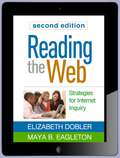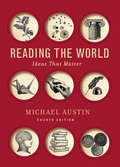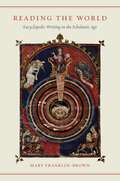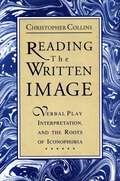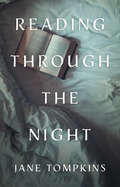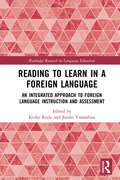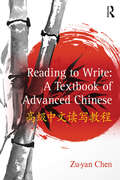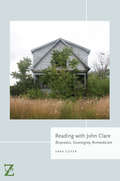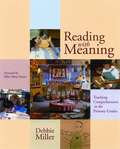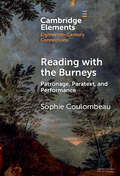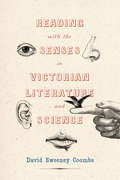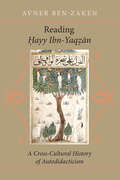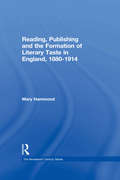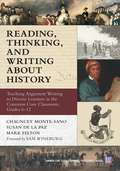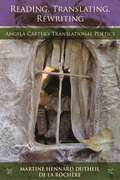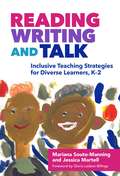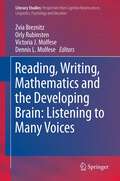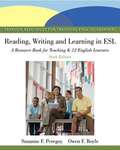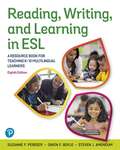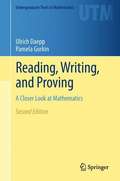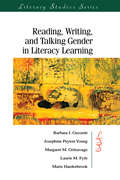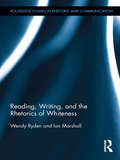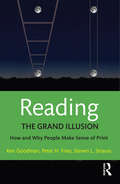- Table View
- List View
Reading the Web, Second Edition
by Maya B. Eagleton Elizabeth Dobler Donald J. LeuToday's students need to know how to locate, comprehend, evaluate, and use online information efficiently and effectively. This widely used teacher guide and course text provides a framework for maximizing students' critical, creative use of the Web in grades 3-8. Research-based strategies for instruction and assessment across the content areas are clearly explained and linked to the Common Core State Standards (CCSS). In a large-size format for easy photocopying, the book is packed with graphics, sidebars, lesson plans, and more than 90 reproducible handouts. Purchasers get access to a Web page where they can download and print the reproducible materials. New to This Edition *Incorporates state-of-the-art research and Web resources. *Chapter on major Web 3.0 developments, such as the rise of social media and mobile devices. *Connections to the CCSS are identified throughout. *Stronger focus on Universal Design for Learning and differentiated instruction. *Larger format facilitates photocopying of the updated reproducible tools.
Reading the World (Fourth Edition)
by Michael AustinThe only global great ideas reader, with new chapters on Ethics & Empathy and Visual Arguments With 77 readings by some of the world’s great thinkers, Reading the World is the only great ideas reader to offer a global perspective, allowing students to explore the development of ideas across cultures, an increasingly important approach in our diverse society. Selections strike a balance between Western and non-Western, classic and contemporary, verbal and visual, and longer and shorter. The new edition features a new chapter on Ethics & Empathy, a new casebook on Visual Arguments, 36 new readings in total, and new guidance on identifying and avoiding bias. This purchase offers access to the digital ebook only.
Reading the World: Encyclopedic Writing in the Scholastic Age
by Mary Franklin-BrownThe thirteenth century saw such a proliferation of new encyclopedic texts that more than one scholar has called it the "century of the encyclopedias. " Variously referred to as a speculum, thesaurus, or imago mundi--the term encyclopedia was not commonly applied to such books until the eighteenth century--these texts were organized in such a way that a reader could easily locate a collection of authoritative statements on any given topic. Because they reproduced, rather than simply summarized, parts of prior texts, these compilations became libraries in miniature. In this groundbreaking study, Mary Franklin-Brown examines writings in Latin, Catalan, and French that are connected to the encyclopedic movement: Vincent of Beauvais's Speculum maius; Ramon Llull's Libre de meravelles, Arbor scientiae, and Arbre de filosofia d'amor; and Jean de Meun's continuation of the Roman de la Rose. Franklin-Brown analyzes the order of knowledge in these challenging texts, describing the wide-ranging interests, the textual practices--including commentary, compilation, and organization--and the diverse discourses that they absorb from preexisting classical, patristic, and medieval writing. She also demonstrates how these encyclopedias, like libraries, became "heterotopias" of knowledge--spaces where many possible ways of knowing are juxtaposed. But Franklin-Brown's study will not appeal only to historians: she argues that a revised understanding of late medievalism makes it possible to discern a close connection between scholasticism and contemporary imaginative literature. She shows how encyclopedists employed the same practices of figuration, narrative, and citation as poets and romanciers, while much of the difficulty of the imaginative writing of this period derives from a juxtaposition of heterogeneous discourses inspired by encyclopedias. With rich and innovative readings of texts both familiar and neglected, Reading the World reveals how the study of encyclopedism can illuminate both the intellectual work and the imaginative writing of the scholastic age.
Reading the World: Encyclopedic Writing in the Scholastic Age
by Mary Franklin-BrownThe thirteenth century saw such a proliferation of new encyclopedic texts that more than one scholar has called it the “century of the encyclopedias.” Variously referred to as a speculum, thesaurus, or imago mundi—the term encyclopedia was not commonly applied to such books until the eighteenth century—these texts were organized in such a way that a reader could easily locate a collection of authoritative statements on any given topic. Because they reproduced, rather than simply summarized, parts of prior texts, these compilations became libraries in miniature. In this groundbreaking study, Mary Franklin-Brown examines writings in Latin, Catalan, and French that are connected to the encyclopedic movement: Vincent of Beauvais’s Speculum maius; Ramon Llull’s Libre de meravelles, Arbor scientiae, and Arbre de filosofia d’amor; and Jean de Meun’s continuation of the Roman de la Rose. Franklin-Brown analyzes the order of knowledge in these challenging texts, describing the wide-ranging interests, the textual practices—including commentary, compilation, and organization—and the diverse discourses that they absorb from preexisting classical, patristic, and medieval writing. She also demonstrates how these encyclopedias, like libraries, became “heterotopias” of knowledge—spaces where many possible ways of knowing are juxtaposed. But Franklin-Brown’s study will not appeal only to historians: she argues that a revised understanding of late medievalism makes it possible to discern a close connection between scholasticism and contemporary imaginative literature. She shows how encyclopedists employed the same practices of figuration, narrative, and citation as poets and romanciers, while much of the difficulty of the imaginative writing of this period derives from a juxtaposition of heterogeneous discourses inspired by encyclopedias. With rich and innovative readings of texts both familiar and neglected, Reading the World reveals how the study of encyclopedism can illuminate both the intellectual work and the imaginative writing of the scholastic age.
Reading the Written Image: Verbal Play, Interpretation, and the Roots of Iconophobia (G - Reference, Information and Interdisciplinary Subjects)
by Christopher CollinsReading the Written Image is a study of the imagination as it is prompted by the verbal cues of literature. Since every literary image is also a mental image, a representation of an absent entity, Collins contends that imagination is a poiesis, a making-up, an act of play for both author and reader. The "willing suspension of disbelief," which Coleridge said "constitutes poetic faith," therefore empowers and directs the reader to construct an imagined world in which particular hypotheses are proposed and demonstrated.Although the imagination as a central concept in poetics emerges into critical debate only in the eighteenth century, it has been a crucial issue for over two millennia in religious, philosophical, and political discourse. The two recognized alternative methodologies in the study of literature, the poetic and the hermeneutic, are opposed on the issue of the written image: poets and readers feel free to imagine, while hermeneuts feel obliged to specify the meanings of images and, failing that, to minimize the importance of imagery. Recognizing this problem, Collins proposes that reading written texts be regarded as a performance, a unique kind of play that transposes what had once been an oral-dramatic situation onto an inner, imaginary stage. He applies models drawn from the psychology of play to support his theory that reader response is essentially a poietic response to a rule-governed set of ludic cues.
Reading through the Night
by Jane TompkinsJane Tompkins, a renowned literature professor and award-winning author, thought she knew what reading was until, struck by a debilitating illness, she finds herself reading day and night because it is all she can do. A lifelong lover of books, she realizes for the first time that if you pay close attention to your reactions as you read, literature can become a path of self-discovery. Tompkins’s inner journey begins when she becomes captivated unexpectedly by an account of friendship between two writers to whom she’d given little thought, Paul Theroux and V. S. Naipaul. Theroux’s memoir launches her on a path of introspection that stretches back to the first weeks of her life in a Bronx hospital, and forward to her relationship with her mother and the structure of her present marriage. Her reading experience, intensified by the feelings of powerlessness and loss of self that come with chronic illness, expands to include writers such as Henning Mankell and Ann Patchett, Alain de Botton, Elena Ferrante, and Anthony Trollope. As she makes her way through their books, she recognizes herself in them, stumbling across patterns of feeling and behavior that have ruled her without her knowing it—envy, a desire for fame, fear of confronting the people she loves, a longing for communion. The reader, along with Tompkins, comes to the realization that literature can be not only a source of information and entertainment, not only a balm and a refuge, but also a key to unlocking long-forgotten memories that lead to a new understanding of one’s life.
Reading to Learn in a Foreign Language: An Integrated Approach to Foreign Language Instruction and Assessment (Routledge Research in Language Education)
by Keiko Koda Junko YamashitaThis book describes a theory-guided approach to Foreign Language (FL) course development, implementation, instruction and assessment. It documents the development and implementation of a theory-guided approach designed to exploit cross-linguistically sharable competencies as resources for promoting FL learning. The volume delineates the processes of (a) identifying cross-linguistically sharable competencies, (b) exploring ways of exploiting sharable competencies as resources in promoting language skills through their purposeful use for content learning, (c) implementing the instructional approach in multiple EFL classrooms, and (d) evaluating the approach by comparing learning outcomes across classrooms. It presents a solid conceptual framework that integrates theories in multiple research domains, including second language acquisition, knowledge acquisition, and language assessment. It also provides detailed descriptions of framework construction and classroom implementation – the two processes that are integral to course design and development.
Reading to Write: A Textbook Of Advanced Chinese
by Zu-Yan ChenTraditionally, reading and writing are believed to be separate but related language processes and teachers follow the conventional wisdom of teaching in-depth reading, with writing as a tag-on issue. Therefore, there exists an increasingly urgent call for a well-rounded reading-writing curriculum and a theoretically-informed, empirically-based, student-centered advanced textbook that aims to develop the synergy between reading and writing. Reading to Write: A Textbook of Advanced Chinese is intended to fill this significant gap. It treats reading and writing as integrative parts and interactive skills in Chinese language teaching, putting them hand-in-hand, supplementing each other.
Reading with John Clare: Biopoetics, Sovereignty, Romanticism (Lit Z)
by Sara GuyerReading with John Clare argues that at the heart of contemporary biopolitical thinking is an insistent repression of poetry. By returning to the moment at which biopolitics is said to emerge simultaneously with romanticism, this project renews our understanding of the operations of contemporary politics and its relation to aesthetics across two centuries.Guyer focuses on a single, exemplary case: the poetry and autobiographical writing of the British poet John Clare (1793–1864). Reading Clare in combination with contemporary theories of biopolitics, Guyer reinterprets romanticism’s political legacies, specifically the belief that romanticism is a direct precursor to the violent nationalisms and redemptive environmentalisms of the twentieth and twenty-first centuries.Guyer offers an alternative account of many of romanticism’s foundational concepts, like home, genius, creativity, and organicism. She shows that contemporary critical theories of biopolitics, despite repeatedly dismissing the aesthetic or poetic dimensions of power as a culpable ideology, emerge within the same rhetorical tradition as the romanticism they denounce. The book thus compels a rethinking of the biopolitical critique of poetry and an attendant reconsideration of romanticism and its concepts.
Reading with Meaning: Teaching Comprehension in the Primary Grades
by Debbie S. MillerIf you have ever wondered how to teach comprehension strategies to primary-age children, read on. First, imagine a primary-grade classroom where all the children are engaged and motivated; where the buzz of excited, emerging readers fills the air; where simultaneously words are sounded out and connections are made between the books of their choice and the experiences of their lives. Then, open these pages. Welcome to Debbie Miller's real classroom where real students are learning to love to read, to write, and are together creating a collaborative and caring environment. In this book, Debbie focuses on how best to teach children strategies for comprehending text. She leads the reader through the course of a year showing how her students learn to become thoughtful, independent, and strategic readers. Through explicit instruction, modeling, classroom discussion, and, most important, by gradually releasing responsibility to her students, Debbie provides a model for creating a climate and culture of thinking and learning. Here you will learn: techniques for modeling thinking; specific examples of modeled strategy lessons for inferring, asking questions, making connections, determining importance in text, creating mental images, and synthesizing information; how to help children make their thinking visible through oral, written, artistic, and dramatic responses to literature; how to successfully develop book clubs as a way for children to share their thinking. Reading with Meaning shows you how to bring your imagined classroom to life. You will emerge with new tools for teaching comprehension strategies and a firm appreciation that a rigorous classroom can also be nurturing and joyful.
Reading with the Burneys: Patronage, Paratext, and Performance (Elements in Eighteenth-Century Connections)
by Sophie CoulombeauThis Element offers a multidimensional study of reading practice and sibling rivalry in late eighteenth-century Britain. The case study is the Aberdeen student and disgraced thief Charles Burney's treatment of Evelina (1778), the debut novel of his sister Frances Burney. Coulombeau uses Charles's manuscript poetry, letters, and marginalia, alongside illustrative prints and circulating library archives, to tell the story of how he attempted to control Evelina's reception in an effort to bolster his own socio-literary status. Uniting approaches drawn from literary studies, biography, bibliography, and the history of the book, the Element enriches scholarly understanding of the reception of Frances Burney's fiction, with broader implications for studies of gender, class, kinship and reading in this period. This title is also available as Open Access on Cambridge Core.
Reading with the Senses in Victorian Literature and Science (Victorian Literature and Culture Series)
by David Sweeney CoombsThe nineteenth-century sciences cleaved sensory experience into two separate realms: the bodily physics of sensation and the mental activity of perception. This division into two discrete categories was foundational to Victorian physics, physiology, and experimental psychology. As David Sweeney Coombs reveals, however, it was equally important to Victorian novelists, aesthetes, and critics, for whom the distinction between sensation and perception promised the key to understanding literature’s seemingly magical power to conjure up tastes, sights, touches, and sounds from the austere medium of print. In Victorian literature, science, and philosophy, the parallel between reading and perceiving gave rise to momentous debates about description as a mode of knowledge as well as how, and even whether, reading about the world differs from experiencing it firsthand.Examining novels and art criticism by George Eliot, Thomas Hardy, Vernon Lee, and Walter Pater alongside scientific works by Hermann von Helmholtz, William James, and others, this book shows how Victorian literature offers us ways not just to touch but to grapple with the material realities that Clifford Geertz called the "hard surfaces of life."
Reading Ḥayy Ibn-Yaqẓān: A Cross-Cultural History of Autodidacticism
by Avner Ben-ZakenCommonly translated as "The Self-Taught Philosopher" or "The Improvement of Human Reason," Ibn-Tufayl's story Hayy Ibn-Yaqzān inspired debates about autodidacticism in a range of historical fields from classical Islamic philosophy through Renaissance humanism and the European Enlightenment. Avner Ben-Zaken's account of how the text traveled demonstrates the intricate ways in which autodidacticism was contested in and adapted to diverse cultural settings.In tracing the circulation of the Hayy Ibn-Yaqzān, Ben-Zaken highlights its key place in four far-removed historical moments. He explains how autodidacticism intertwined with struggles over mysticism in twelfth-century Marrakesh, controversies about pedagogy in fourteenth-century Barcelona, quarrels concerning astrology in Renaissance Florence, and debates pertaining to experimentalism in seventeenth-century Oxford. In each site and period, Ben-Zaken recaptures the cultural context that stirred scholars to relate to ayy Ibn-Yaqān and demonstrates how the text moved among cultures, leaving in its wake translations, interpretations, and controversies as various as the societies themselves. Pleas for autodidacticism, Ben-Zaken shows, not only echoed within close philosophical discussions; they surfaced in struggles for control between individuals and establishments. Presented as self-contained histories, these four moments together form a historical collage of autodidacticism across cultures from the late Medieval era to early modern times. The first book-length intellectual history of autodidacticism, this novel, thought-provoking work will interest a wide range of historians, including scholars of the history of science, philosophy, literature, Europe, and the Middle East.
Reading, Publishing and the Formation of Literary Taste in England, 1880-1914 (The Nineteenth Century Series)
by Mary HammondBetween 1880 and 1914, England saw the emergence of an unprecedented range of new literary forms from Modernism to the popular thriller. Not coincidentally, this period also marked the first overt references to an art/market divide through which books took on new significance as markers of taste and class. Though this division has received considerable attention relative to the narrative structures of the period's texts, little attention has been paid to the institutions and ideologies that largely determined a text's accessibility and circulated format and thus its mode of address to specific readerships. Hammond addresses this gap in scholarship, asking the following key questions: How did publishing and distribution practices influence reader choice? Who decided whether or not a book was a 'classic'? In a patriarchal, class-bound literary field, how were the symbolic positions of 'author' and 'reader' affected by the increasing numbers of women who not only bought and borrowed, but also wrote novels? Using hitherto unexamined archive material and focussing in detail on the working practices of publishers and distributors such as Oxford University Press and W.H. Smith and Sons, Hammond combines the methodologies of sociology, literary studies and book history to make an original and important contribution to our understanding of the cultural dynamics and rhetorics of the fin-de-siècle literary field in England.
Reading, Thinking, and Writing About History: Teaching Argument Writing to Diverse Learners in the Common Core Classroom, Grades 6-12
by Susan B. Neuman D. Ray Reutzel Mark Felton Chauncey Monte-Sano Susan De La PazAlthough the Common Core and C3 Framework highlight literacy and inquiry as central goals for social studies, they do not offer guidelines, assessments, or curriculum resources. This practical guide presents six research-tested historical investigations along with all corresponding teaching materials and tools that have improved the historical thinking and argumentative writing of academically diverse students. Each investigation integrates reading, analysis, planning, composing, and reflection into a writing process that results in an argumentative history essay. Primary sources have been modified to allow struggling readers access to the material. Web links to original unmodified primary sources are also provided, along with other sources to extend investigations. The authors include sample student essays from each investigation to illustrate the progress of two different learners and explain how to support students' development. Each chapter includes these helpful sections: Historical Background, Literacy Practices Students Will Learn, How to Teach This Investigation, How Might Students Respond?, Student Writing and Teacher Feedback, Lesson Plans and Materials.
Reading, Translating, Rewriting: Angela Carter's Translational Poetics
by Martine Hennard Dutheil de la RochèreIn translating Charles Perrault's seventeenth-century Histoires ou contes du temps passé, avec des Moralités into English, Angela Carter worked to modernize the language and message of the tales before rewriting many of them for her own famous collection of fairy tales for adults, The Bloody Chamber, published two years later. In Reading, Translating, Rewriting: Angela Carter's Translational Poetics, author Martine Hennard Dutheil de la Rochère delves into Carter's The Fairy Tales of Charles Perrault (1977) to illustrate that this translation project had a significant impact on Carter's own writing practice. Hennard combines close analyses of both texts with an attention to Carter's active role in the translation and composition process to explore this previously unstudied aspect of Carter's work. She further uncovers the role of female fairy-tale writers and folktales associated with the Grimms' Kinder- und Hausmärchen in the rewriting process, unlocking new doors to The Bloody Chamber. Hennard begins by considering the editorial evolution of The Fairy Tales of Charles Perrault from 1977 to the present day, as Perrault's tales have been rediscovered and repurposed. In the chapters that follow, she examines specific linkages between Carter's Perrault translation and The Bloody Chamber, including targeted analysis of the stories of Red Riding Hood, Bluebeard, Puss-in-Boots, Beauty and the Beast, Sleeping Beauty, and Cinderella. Hennard demonstrates how, even before The Bloody Chamber, Carter intervened in the fairy-tale debate of the late 1970s by reclaiming Perrault for feminist readers when she discovered that the morals of his worldly tales lent themselves to her own materialist and feminist goals. Hennard argues that The Bloody Chamber can therefore be seen as the continuation of and counterpoint to The Fairy Tales of Charles Perrault, as it explores the potential of the familiar stories for alternative retellings. While the critical consensus reads into Carter an imperative to subvert classic fairy tales, the book shows that Carter valued in Perrault a practical educator as well as a proto-folklorist and went on to respond to more hidden aspects of his texts in her rewritings.
Reading, Writing, And Talk: Inclusive Teaching Strategies For Diverse Learners, K-2 (Language And Literacy)
by Gloria Ladson-Billings Mariana Souto-Manning Jessica MartellThis book invites readers to consider ways in which their language and literacy teaching practices can better value and build upon the brilliance of every child. In doing so, it highlights the ways in which teachers and students build on diversities as strengths to create more inclusive and responsive classrooms. After inviting readers to consider and better understand the diverse language and literacy practices of diverse chidlren, it offers invitations for teachers to make these practices foundational in their own classrooms and to consider meaningful possibilities for learning authentically with young children in primary grades. It features chapters that focus on oral language, reading, and writing development, all while recognizing that these are not separate. In each of these chapters, readers are invited to consider diverse possibilities, perspectives, and points of view in practice within primary grades classrooms. Throughout, it offers ways to foster classroom learning communities where racially, culturally, and linguistically diverse chidlren are supported and valued.
Reading, Writing, Mathematics and the Developing Brain: Listening to Many Voices
by Orly Rubinsten Dennis L. Molfese Zvia Breznitz Victoria J. MolfeseThis valuable addition to the literature offers readers a comprehensive overview of recent brain imaging research focused on reading, writing and mathematics--a research arena characterized by rapid advances that follow on the heels of fresh developments and techniques in brain imaging itself. With contributions from many of the lead scientists in this field, a number of whom have been responsible for key breakthroughs, the coverage deals with the commonalities of, as well as the differences between, brain activity related to the three core educational topics. At the same time, the volume addresses vital new information on both brain and behavior indicators of developmental problems, and points out the new directions being pursued using current advances in brain imaging technologies as well as research-based interventions. The book is also a tribute to a new Edmund, J Safra Brain center for the study of learning Disabilities at the University of Haifa-Israel.
Reading, Writing, and Errant Subjects in Inquisitorial Spain
by Ryan PrendergastReading, Writing, and Errant Subjects in Inquisitorial Spain explores the conception and production of early modern Spanish literary texts in the context of the inquisitorial socio-cultural environment of the sixteenth and seventeenth centuries. Author Ryan Prendergast analyzes instances of how the elaborate censorial system and the threat of punishment that both the Inquisition and the Crown deployed did not deter all writers from incorporating, confronting, and critiquing legally sanctioned practices and the exercise of institutional power designed to induce conformity and maintain orthodoxy. The book maps out how texts from different literary genres scrutinize varying facets of inquisitorial discourse and represent the influence of the Inquisition on early modern Spanish subjects, including authors and readers. Because of its incorporation of inquisitorial scenes and practices as well as its integration of numerous literary genres, Don Quixote serves as the book's principal literary resource. The author also examines the Moorish novel/ la novela morisca with special attention to the question of the religious and cultural Others, in particular the Muslim subject; the Picaresque novel/la novela picaresca, focusing on the issues of confession and punishment; and theatrical representations and dramatic texts, which deal with the public performance of ideology. The texts, which had differing levels of contact with censorial processes ranging from complete prohibition to no censorship, incorporate the issues of control, intolerance, and resistance. Through his close readings of Golden Age texts, Prendergast investigates the strategies that literary characters, many of them represented as legally or socially errant subjects, utilize to negotiate the limits that authorities and society attempt to impose on them, and demonstrates the pervasive nature of the inquisitorial specter in sixteenth- and seventeenth-century Spanish cultural production.
Reading, Writing, and Learning in ESL: A Resource Book for Teaching K-12 English Learners (6th Edition)
by Suzanne F. Peregoy Owen F. BoyleReading, Writing, and Learning in ESL: A Resource Book for Teaching K-12 English Learners, Sixth Edition, is a comprehensive, reader-friendly resource book that provides a wealth of teaching ideas for promoting oral language, reading, and writing development in English for K-12 English learners. The book provides up-to-date language acquisition theory, classroom organization, teaching strategies, and assessment procedures for effective English learner instruction.
Reading, Writing, and Learning in ESL: A Resource Book for Teaching K-12 Multilingual Learners
by Suzanne F. Peregoy Owen F. Boyle Steven AmendumReading, Writing, and Learning in ESL is a comprehensive resource for teaching and assessing K-12 multilingual learners and actively involving them in their own education. It examines up-to-date language acquisition theory as it relates to instruction. Research-based strategies help promote oral language, reading, writing and academic development. Real-life scenarios demonstrate diverse classroom cultures. This useful resource helps you learn vital content and skills to support your future instruction with multilingual learners in K-12 settings. The 8th Edition emphasizes practical classroom applications of evidence-based instructional strategies. Updated cases, research, theory and terminology reflect recent findings and perspectives.
Reading, Writing, and Proving: A Closer Look at Mathematics (2nd Edition) (Undergraduate Texts in Mathematics)
by Ulrich Daepp Pamela Gorkin<p>This book, which is based on Pólya's method of problem solving, aids students in their transition from calculus (or precalculus) to higher-level mathematics. The book begins by providing a great deal of guidance on how to approach definitions, examples, and theorems in mathematics and ends with suggested projects for independent study. <p>Students will follow Pólya's four step approach: analyzing the problem, devising a plan to solve the problem, carrying out that plan, and then determining the implication of the result. In addition to the Pólya approach to proofs, this book places special emphasis on reading proofs carefully and writing them well. The authors have included a wide variety of problems, examples, illustrations and exercises, some with hints and solutions, designed specifically to improve the student's ability to read and write proofs. <p>Historical connections are made throughout the text, and students are encouraged to use the rather extensive bibliography to begin making connections of their own. While standard texts in this area prepare students for future courses in algebra, this book also includes chapters on sequences, convergence, and metric spaces for those wanting to bridge the gap between the standard course in calculus and one in analysis.</p>
Reading, Writing, and Talking Gender in Literacy Learning (IRA's Literacy Studies Series)
by Barbara J. Guzzetti Josephine Peyto Young Margaret M. Gritsavage Laurie M. Fyfe Marie HardenbrookUntil now, there has been no systematic analysis or review of the research on gender and literacy. With all the media attention and research surveys surrounding gender bias and the inequities that continue to flourish in education, a synthesis of the research studies was needed to raise awareness of gender issues in learning and literacy, to provide successful interventions and recommendations to educators, and to point out the direction for future inquiries by examining the unanswered questions of the existing research. For the convenience of readers, the studies are organized by genre: gender and discussion, reading, writing, electronic text, and literacy autobiography. Published by International Reading Association
Reading, Writing, and the Rhetorics of Whiteness (Routledge Studies in Rhetoric and Communication)
by Ian Marshall Wendy RydenIn this volume, Ryden and Marshall bring together the field of composition and rhetoric with critical whiteness studies to show that in our "post race" era whiteness and racism not only survive but actually thrive in higher education. As they examine the effects of racism on contemporary literacy practices and the rhetoric by which white privilege maintains and reproduces itself, Ryden and Marshall consider topics ranging from the emotional investment in whiteness to the role of personal narrative in reconstituting racist identities to critiques of the foundational premises of writing programs steeped in repudiation of despised discourses. Marshall and Ryden alternate chapters to sustain a multi-layered dialogue that traces the rhetorical complexities and contradictions of teaching English and writing in a university setting. Their lived experiences as faculty and administrators serve to underscore the complex code of whiteness even as they push to decode it and demonstrate how their own pedagogical practices are raced and racialized in multiple ways. Collectively, the essays ask instructors and administrators to consider more carefully the pernicious nature of whiteness in their professional activities and how it informs our practices.
Reading- The Grand Illusion: How and Why People Make Sense of Print
by Kenneth Goodman Peter H. Fries Steven L. StraussWhat is reading? In this groundbreaking book, esteemed researchers Ken Goodman, Peter Fries, and Steven Strauss, explain not only what reading really is but also why common sense makes it seem to be something quite different from that reality. How can this grand illusion be explained? That is the purpose of this book. As the authors show, unraveling the secrets of the grand illusion of reading teaches about far more than reading itself, but also about how remarkable human language is, how the brain uses language to navigate the world, what it means to be human. Each author brings a different perspective, but all share a common view of the reading process. Together they provide a clear and surprising exposition of the reading process, in which they involve readers of this book in exploring the ways they themselves read and make sense of written language while their eyes fixate on fewer than 70 percent of the words in the text. In addition, the authors engage in a cross-disciplinary discussion about how readers use the brain, eyes, and language in reading. The different perspectives provide depth to the authors’ description of reading. The information presented in this book will be new to many teachers, researchers, teacher educators, and the public alike. The final chapter draws on the understandings from the book to challenge the treatment of reading and writing as school subjects and offers the basis for supporting literacy development as a natural extension of oral language development.
